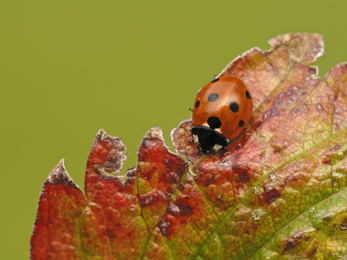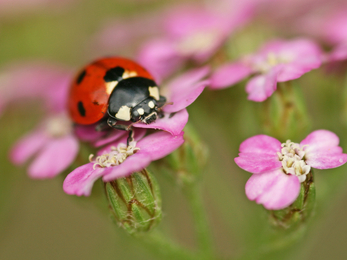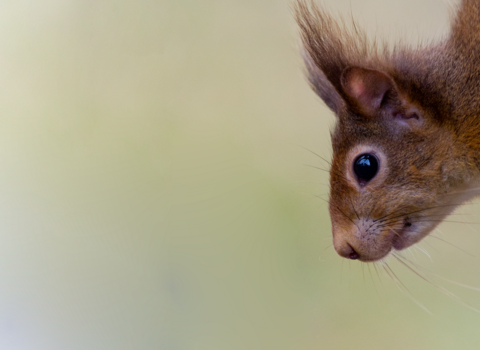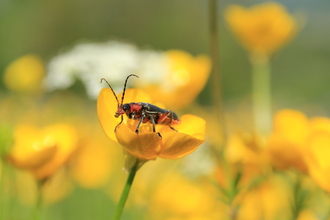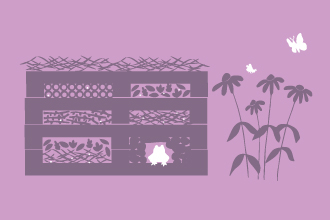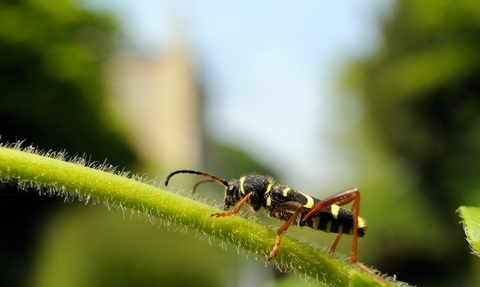
Nick Upton/2020VISION
How to identify beetles
What is a beetle?
Beetles are insects from the order Coleoptera — which means 'sheath-winged'. In most beetles, the front pair of wings has adapted to form tough, protective cases that lie across their back, giving them their armoured appearance. These wing cases (called elytra), protect the more delicate wings that are actually used for flight. When they're ready to take off, the wing cases pop up and the functional wings come out, ready to launch the beetle into the air. Not all beetles can fly, and some have really short wing cases that don't completely hide the abdomen.
Which beetles am I likely to see?
Beetles are one of the most diverse groups of animals on the planet, with over 400,000 different species across the world — there are over 4,000 species in the UK alone! Even without looking too hard, it's easy to stumble across beetles in almost any habitat. They sit on flowers, climb up trees, and even wander across paths. There are also plenty of large, or brightly coloured beetles to catch our attention, from the big and bulbous bloody-nosed beetle, to the bright red or yellow ladybirds.
We've picked out a few of the more recognisable beetles that you're likely to bump into, but first here are a couple of words from beetle biology that you might find helpful:
- Pronotum - the hard, plate-like structure covering the part of the body just behind the head
- Elytra (singular elytron) - the hardened wing cases that cover the rear body section of most beetles
Bloody-nosed beetle
When & where: April-June. Widespread in south and central England, on grassland, heathland, and hedgerows. Often seen plodding across paths.
Description: A large (up to 23 mm), shiny black beetle with a bluish sheen. The body is rounded, and the pronotum is wider at the front than the back. The antennae are distinctly bobbly.
The similar small bloody-nosed beetle only reaches around 11 mm long and has a more evenly rounded pronotum.
Green tiger beetle
When & where: April-September. Across the UK on bare, sandy ground on heathland, grassland, dunes, and often brownfield sites.
Description: A large (up to 15mm) and distinctive metallic green beetle with yellowish spots on the wing cases, purple-bronze legs, and large, prominent eyes.
Devil's coach horse
When & where: April-October. Widespread in a variety of habitats, including gardens. Largely nocturnal, hiding under logs and stones during the day.
Description: A long, slender black beetle with large jaws and short wing cases that don't cover the abdomen. When threatened, it curls its abdomen up in a scorpion-like posture.
Harlequin ladybird
When & where: March-November. An introduced species that's now common across the UK. Often tries to enter buildings in autumn, looking for somewhere to spend the winter.
Description: A highly variable ladybird. Can be yellow, orange, red, or black, with 0-21 spots. The most commonly seen forms are orange with 15-21 black spots, or black with 2-4 orange or red spots. The pronotum is often white, with a large, black M-shaped mark. Larger than many similar ladybirds (over 5 mm), with reddish-brown legs.
7-spot ladybird
When & where: March-October. Widespread and common across the UK.
Description: One of our most familiar ladybirds, with seven small black spots spread symmetrically across its red back: three on each wing case, with the seventh at the front spread across both of them. It has black legs.
Swollen-thighed beetle
When & where: April-September. Meadows and grassy areas in Wales and the southern half of England. Often visits flowers on sunny days.
Description: A slender, metallic green beetle, with a gap between the two wing cases. Males have obviously swollen thighs.
Wasp beetle
When & where: May-July. Widespread in England and Wales, rarer in Scotland. Found in woodlands and hedgerows, often visiting flowers.
Description: A black and yellow beetle that mimics the patterning of a wasp, with several yellow bands across the wing cases. It has long antennae (though relatively short for a longhorn beetle) that are reddish near the base and darker towards the tip. The legs are also reddish, with darker thighs.
Black-and-yellow longhorn beetle
When & where: May-August. Widespread in England and Wales, reaching southwest Scotland. Found around woodland edges and hedgerows. Often visits flowers, especially umbellifers, brambles, and thistles.
Description: A distinctive black and yellow beetle, with long legs and very long antennae. The head and pronotum are black, the wing cases are yellow with black markings and taper towards the rear. The black markings vary, but usually appear as two complete black lines on the rear half, and two broken black lines on the front half.
Black-spotted longhorn beetle
When & where: April-August. Widespread in England, Wales, and Scotland. Found in woodland and wooded parks, often visiting flowers.
Description: A mottled yellowish-brown and black beetle. It has two large black spots on its wing cases, with a pale band either side of each spot. The antennae are relatively short for a longhorn beetle.
Golden-bloomed grey longhorn beetle
When & where: April-August. Widespread in England, though scarcer in the north and absent from the southwest. Found in meadows and hedgerows, often sitting on umbellifer or thistle flowers.
Description: A large and distinctive beetle. Mostly a shining gold colour with black mottling. The antennae are incredibly long, with bands of black and bluish-grey.
Stag beetle
When & where: May-August. Woods, parks and gardens in south-east England. Males can be seen flying at dusk.
Description: A huge, bulky beetle that can be 50-75 mm long. They have a broad black head and pronotum, and shiny, brownish wing cases - though these are darker in females. Males can be instantly recognised by their massive, reddish-brown antler-like jaws. Females have smaller jaws and resemble lesser stag beetles, but can be told apart by the shiny brown hue of their wing cases.
Lesser stag beetle
When & where: May-September. Woodland, parks and occasionally gardens, in England north to Yorkshire, and parts of Wales.
Description: A big black beetle that looks very similar to the larger female stag beetle, but only reaches lengths of 30 mm. Lesser stag beetles can be recognised by their matt black wing cases, which lack the shiny brown hue of the female stag beetle's.
Rose chafer
When & where: May-October. Woodland, parks and occasionally gardens. Scattered distribution across southern England and Wales, scarcer further north.
Description: A large, iridescent green beetle with short, creamy white streaks on the wing cases. There is a distinct V shape where the wing cases meet. The green can be coppery or have golden hues.
Rosemary beetle
When & where: Can be seen all year, but often most common in May and June. Found on herbs, including rosemary, lavender and thyme.
Description: A small, shiny beetle with metallic green and purplish-red stripes along its back. The pronotum is mostly metallic green with some purplish-red markings. The legs are a pale reddish colour.
Common red soldier beetle
When & where: June-August. Very common throughout the UK. Usually found on flowers, particularly umbellifers and thistles. Pairs are often found mating.
Description: A small, reddish-orange beetle. The wing cases are slightly brown or yellow-tinged, with black tips at the rear. The legs are mostly red, but are black at the end.
Cantharis rustica
When & where: May-August. Very common throughout Wales and southern and central England. Scarcer in northern England and Scotland. Usually found on flowers, particularly umbellifers and thistles.
Description: A fairly large black and red beetle. The wing cases are glossy black and the pronotum is red with a black heart-shaped mark in the centre. The legs are black with a variable amount of red at the base.
Red-headed cardinal beetle
When & where: April-July. Widespread in England and Wales, though more scarce in northern England. Found close to wooded areas, sometimes basking on large leaves or visiting flowers, particularly umbellifers.
Description: A large red beetle with black legs and antennae. The completely red wings cases and head help tell it apart from any similar species.
The black-headed cardinal beetle is similar, but can be recognised by its black head.
Not a beetle!
The word bug is often used to describe any sort of insect, including beetles. But there is actually a group of insects known as the true bugs, from the order Hemiptera. Some of these species, such as shieldbugs, can sometimes be mistaken for beetles. One of the key differences is in the mouthparts - beetles have pincer-like mandibles, but bugs have a hardened snout called a rostrum. Like beetles, shieldbugs have hardened forewings, but only half of the wing is hardened, the rest is membranous. Their wings cross over each other when they're at rest, so they don't show the neat line between the wing cases that beetles do.












